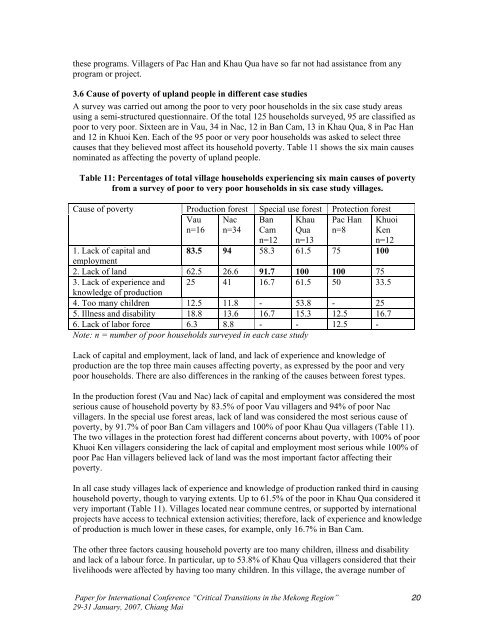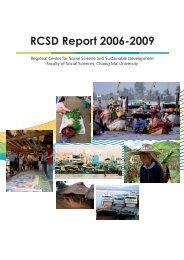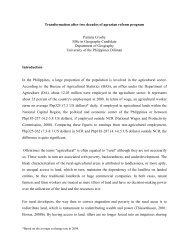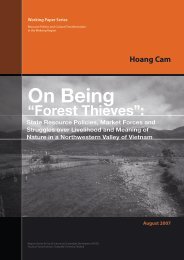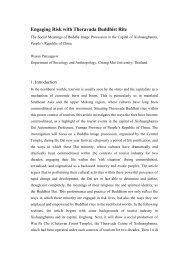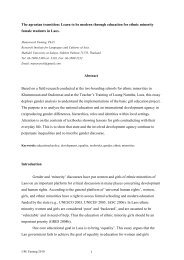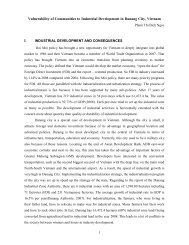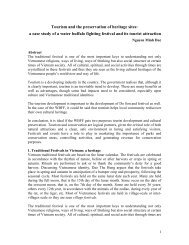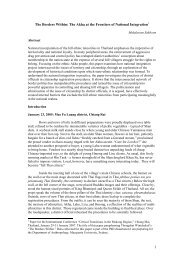The Impact of the Renovation Policies on the Livelihoods of ... - RCSD
The Impact of the Renovation Policies on the Livelihoods of ... - RCSD
The Impact of the Renovation Policies on the Livelihoods of ... - RCSD
You also want an ePaper? Increase the reach of your titles
YUMPU automatically turns print PDFs into web optimized ePapers that Google loves.
<str<strong>on</strong>g>the</str<strong>on</strong>g>se programs. Villagers <str<strong>on</strong>g>of</str<strong>on</strong>g> Pac Han and Khau Qua have so far not had assistance from anyprogram or project.3.6 Cause <str<strong>on</strong>g>of</str<strong>on</strong>g> poverty <str<strong>on</strong>g>of</str<strong>on</strong>g> upland people in different case studiesA survey was carried out am<strong>on</strong>g <str<strong>on</strong>g>the</str<strong>on</strong>g> poor to very poor households in <str<strong>on</strong>g>the</str<strong>on</strong>g> six case study areasusing a semi-structured questi<strong>on</strong>naire. Of <str<strong>on</strong>g>the</str<strong>on</strong>g> total 125 households surveyed, 95 are classified aspoor to very poor. Sixteen are in Vau, 34 in Nac, 12 in Ban Cam, 13 in Khau Qua, 8 in Pac Hanand 12 in Khuoi Ken. Each <str<strong>on</strong>g>of</str<strong>on</strong>g> <str<strong>on</strong>g>the</str<strong>on</strong>g> 95 poor or very poor households was asked to select threecauses that <str<strong>on</strong>g>the</str<strong>on</strong>g>y believed most affect its household poverty. Table 11 shows <str<strong>on</strong>g>the</str<strong>on</strong>g> six main causesnominated as affecting <str<strong>on</strong>g>the</str<strong>on</strong>g> poverty <str<strong>on</strong>g>of</str<strong>on</strong>g> upland people.Table 11: Percentages <str<strong>on</strong>g>of</str<strong>on</strong>g> total village households experiencing six main causes <str<strong>on</strong>g>of</str<strong>on</strong>g> povertyfrom a survey <str<strong>on</strong>g>of</str<strong>on</strong>g> poor to very poor households in six case study villages.Cause <str<strong>on</strong>g>of</str<strong>on</strong>g> povertyProducti<strong>on</strong> forest Special use forest Protecti<strong>on</strong> forestVaun=16Nacn=34BanCamn=12KhauQuan=13Pac Hann=8KhuoiKenn=121. Lack <str<strong>on</strong>g>of</str<strong>on</strong>g> capital and 83.5 94 58.3 61.5 75 100employment2. Lack <str<strong>on</strong>g>of</str<strong>on</strong>g> land 62.5 26.6 91.7 100 100 753. Lack <str<strong>on</strong>g>of</str<strong>on</strong>g> experience and 25 41 16.7 61.5 50 33.5knowledge <str<strong>on</strong>g>of</str<strong>on</strong>g> producti<strong>on</strong>4. Too many children 12.5 11.8 - 53.8 - 255. Illness and disability 18.8 13.6 16.7 15.3 12.5 16.76. Lack <str<strong>on</strong>g>of</str<strong>on</strong>g> labor force 6.3 8.8 - - 12.5 -Note: n = number <str<strong>on</strong>g>of</str<strong>on</strong>g> poor households surveyed in each case studyLack <str<strong>on</strong>g>of</str<strong>on</strong>g> capital and employment, lack <str<strong>on</strong>g>of</str<strong>on</strong>g> land, and lack <str<strong>on</strong>g>of</str<strong>on</strong>g> experience and knowledge <str<strong>on</strong>g>of</str<strong>on</strong>g>producti<strong>on</strong> are <str<strong>on</strong>g>the</str<strong>on</strong>g> top three main causes affecting poverty, as expressed by <str<strong>on</strong>g>the</str<strong>on</strong>g> poor and verypoor households. <str<strong>on</strong>g>The</str<strong>on</strong>g>re are also differences in <str<strong>on</strong>g>the</str<strong>on</strong>g> ranking <str<strong>on</strong>g>of</str<strong>on</strong>g> <str<strong>on</strong>g>the</str<strong>on</strong>g> causes between forest types.In <str<strong>on</strong>g>the</str<strong>on</strong>g> producti<strong>on</strong> forest (Vau and Nac) lack <str<strong>on</strong>g>of</str<strong>on</strong>g> capital and employment was c<strong>on</strong>sidered <str<strong>on</strong>g>the</str<strong>on</strong>g> mostserious cause <str<strong>on</strong>g>of</str<strong>on</strong>g> household poverty by 83.5% <str<strong>on</strong>g>of</str<strong>on</strong>g> poor Vau villagers and 94% <str<strong>on</strong>g>of</str<strong>on</strong>g> poor Nacvillagers. In <str<strong>on</strong>g>the</str<strong>on</strong>g> special use forest areas, lack <str<strong>on</strong>g>of</str<strong>on</strong>g> land was c<strong>on</strong>sidered <str<strong>on</strong>g>the</str<strong>on</strong>g> most serious cause <str<strong>on</strong>g>of</str<strong>on</strong>g>poverty, by 91.7% <str<strong>on</strong>g>of</str<strong>on</strong>g> poor Ban Cam villagers and 100% <str<strong>on</strong>g>of</str<strong>on</strong>g> poor Khau Qua villagers (Table 11).<str<strong>on</strong>g>The</str<strong>on</strong>g> two villages in <str<strong>on</strong>g>the</str<strong>on</strong>g> protecti<strong>on</strong> forest had different c<strong>on</strong>cerns about poverty, with 100% <str<strong>on</strong>g>of</str<strong>on</strong>g> poorKhuoi Ken villagers c<strong>on</strong>sidering <str<strong>on</strong>g>the</str<strong>on</strong>g> lack <str<strong>on</strong>g>of</str<strong>on</strong>g> capital and employment most serious while 100% <str<strong>on</strong>g>of</str<strong>on</strong>g>poor Pac Han villagers believed lack <str<strong>on</strong>g>of</str<strong>on</strong>g> land was <str<strong>on</strong>g>the</str<strong>on</strong>g> most important factor affecting <str<strong>on</strong>g>the</str<strong>on</strong>g>irpoverty.In all case study villages lack <str<strong>on</strong>g>of</str<strong>on</strong>g> experience and knowledge <str<strong>on</strong>g>of</str<strong>on</strong>g> producti<strong>on</strong> ranked third in causinghousehold poverty, though to varying extents. Up to 61.5% <str<strong>on</strong>g>of</str<strong>on</strong>g> <str<strong>on</strong>g>the</str<strong>on</strong>g> poor in Khau Qua c<strong>on</strong>sidered itvery important (Table 11). Villages located near commune centres, or supported by internati<strong>on</strong>alprojects have access to technical extensi<strong>on</strong> activities; <str<strong>on</strong>g>the</str<strong>on</strong>g>refore, lack <str<strong>on</strong>g>of</str<strong>on</strong>g> experience and knowledge<str<strong>on</strong>g>of</str<strong>on</strong>g> producti<strong>on</strong> is much lower in <str<strong>on</strong>g>the</str<strong>on</strong>g>se cases, for example, <strong>on</strong>ly 16.7% in Ban Cam.<str<strong>on</strong>g>The</str<strong>on</strong>g> o<str<strong>on</strong>g>the</str<strong>on</strong>g>r three factors causing household poverty are too many children, illness and disabilityand lack <str<strong>on</strong>g>of</str<strong>on</strong>g> a labour force. In particular, up to 53.8% <str<strong>on</strong>g>of</str<strong>on</strong>g> Khau Qua villagers c<strong>on</strong>sidered that <str<strong>on</strong>g>the</str<strong>on</strong>g>irlivelihoods were affected by having too many children. In this village, <str<strong>on</strong>g>the</str<strong>on</strong>g> average number <str<strong>on</strong>g>of</str<strong>on</strong>g>Paper for Internati<strong>on</strong>al C<strong>on</strong>ference “Critical Transiti<strong>on</strong>s in <str<strong>on</strong>g>the</str<strong>on</strong>g> Mek<strong>on</strong>g Regi<strong>on</strong>”29-31 January, 2007, Chiang Mai20


